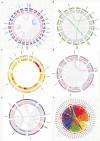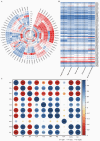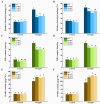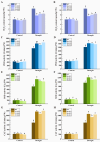Evolution analysis of GH3 gene family in five Rosaceae species and FaGH3.17, FaGH3.18 improve drought tolerance in transgenic Arabidopsis
- PMID: 40604382
- PMCID: PMC12220510
- DOI: 10.1186/s12870-025-06689-2
Evolution analysis of GH3 gene family in five Rosaceae species and FaGH3.17, FaGH3.18 improve drought tolerance in transgenic Arabidopsis
Abstract
Background: Gretchen Hagen 3 (GH3), one of the important auxin-responsive gene families, plays essential roles in plant growth, development process, and stress response by regulating hormone homeostasis. However, the evolutionary analysis of the GH3 gene family in Rosaceae species has not been well-studied and the specifc functions of Fragaria ananassa are not well-documented.
Results: In the current study, 64 members of the GH3 family genes were identifed from five Rosaceae species and divided into 8 groups. According to the comprehensive analysis of evolutionary relationship, collinearity, selection pressure and codon bias, the GH3 gene family was found to be highly conserved across these Rosaceae species, suggesting that purifying selection was a significant force in the evolution of GH3 genes, and the expansion of the GH3 gene family in Rosaceae species might be attributed to fragment duplication. Meanwhile, the codon bias of GH3s in subfamily G and K showed a relatively strong codon bias. Significantly, both FaGH3.17 and FaGH3.18 were localized in the cytoplasm and nucleus. Additionally, compared with the wild type (WT), the malondialdehyde (MDA) content and relative conductivity of FaGH3.17 and FaGH3.18 transgenic Arabidopsis were decreased, while the superoxide dismutase (SOD), peroxidase (POD), and catalase (CAT) activities were increased under drought stress. The above results indicate that overexpression of FaGH3.17 and FaGH3.18 signifcantly enhanced the tolerance to drought in transgenic Arabidopsis.
Conclusions: The study provides crucial insights into the evolution of the GH3 gene family in Rosaceae species and provides a theoretical basis for further investigation on the function of FaGH3s.
Keywords: FaGH3.17; FaGH3.18; Drought stress; Evolution; Rosaceae species.
© 2025. The Author(s).
Conflict of interest statement
Declarations. Ethics approval and consent to participate: Not applicable. Consent for publication: Not applicable. Competing interests: The authors declare no competing interests.
Figures










Similar articles
-
Comparative analysis of POD gene family and expression differentiation under NaCl, H2O2 and PEG stresses in sorghum.BMC Genomics. 2025 Jul 17;26(1):674. doi: 10.1186/s12864-025-11858-6. BMC Genomics. 2025. PMID: 40676507 Free PMC article.
-
Overexpression of a Malus baccata (L.) Borkh WRKY Factor Gene MbWRKY33 Increased High Salinity Stress Tolerance in Arabidopsis thaliana.Int J Mol Sci. 2025 Jun 18;26(12):5833. doi: 10.3390/ijms26125833. Int J Mol Sci. 2025. PMID: 40565296 Free PMC article.
-
Overexpression of the β-Glucosidase Gene SpBGLU25 from the Desert Pioneer Plant Stipagrostis pennata Enhances the Drought Tolerance in Arabidopsis.Int J Mol Sci. 2025 Jul 11;26(14):6663. doi: 10.3390/ijms26146663. Int J Mol Sci. 2025. PMID: 40724915 Free PMC article.
-
Home treatment for mental health problems: a systematic review.Health Technol Assess. 2001;5(15):1-139. doi: 10.3310/hta5150. Health Technol Assess. 2001. PMID: 11532236
-
Psychological and/or educational interventions for the prevention of depression in children and adolescents.Cochrane Database Syst Rev. 2004;(1):CD003380. doi: 10.1002/14651858.CD003380.pub2. Cochrane Database Syst Rev. 2004. Update in: Cochrane Database Syst Rev. 2011 Dec 07;(12):CD003380. doi: 10.1002/14651858.CD003380.pub3. PMID: 14974014 Updated.
References
-
- Zhang H, Zhu J, Gong Z, Zhu JK. Abiotic stress responses in plants. Nat Rev Genet. 2022;23(2):104–19. - PubMed
-
- Li H, Yang J, Ma R, An X, Pan F, Zhang S, et al. Genome-wide identification and expression analysis of MYB gene family in Cajanus cajan and CcMYB107 improves plant drought tolerance. Physiol Plant. 2023;175(4):e13954. - PubMed
-
- Park JE, Park JY, Kim YS, Staswick PE, Jeon J, Yun J, et al. GH3-mediated auxin homeostasis links growth regulation with stress adaptation response in Arabidopsis. J Biol Chem. 2007;282(13):10036–46. - PubMed
MeSH terms
Substances
Grants and funding
LinkOut - more resources
Full Text Sources
Miscellaneous

